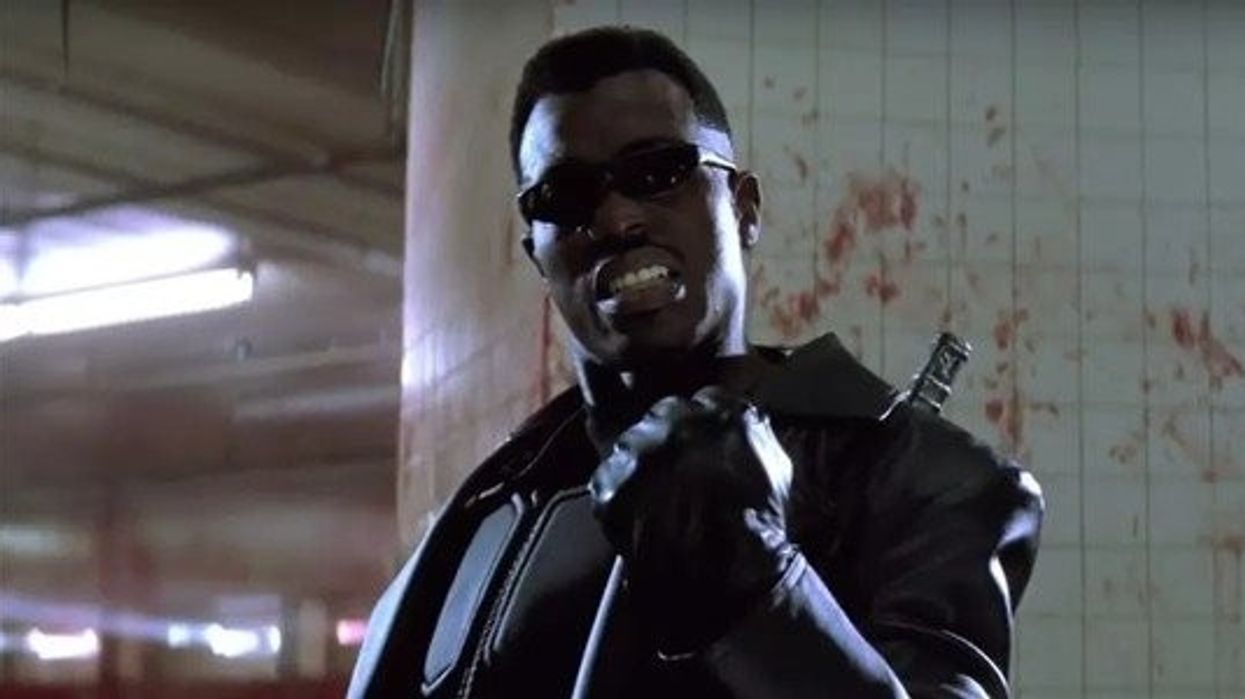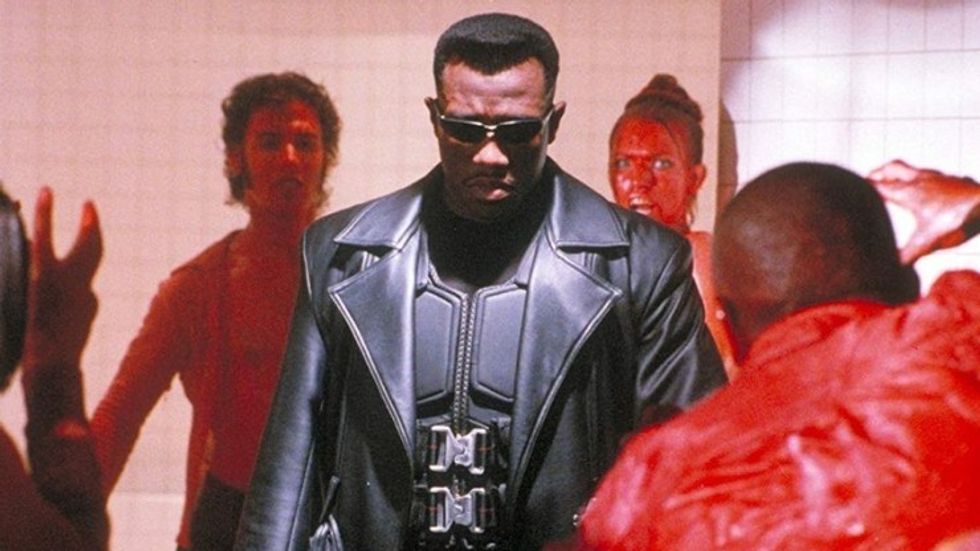How 'Blade' Kickstarted the MCU and Every Other Superhero Movie
If you like the gritty superhero world where everyone wears leather, then you can thank Blade and its influence on the genre.

I remember watching Blade in the dark garage of my best friend's house when I was 12. The world of vampire hunting mixed with the complete badassery of Wesley Snipes' Blade had me in awe of the film. It wasn’t until a few years later that I realized that Blade was originally a comic book character, and I don’t think I was alone.
Superhero movies have been heavily critiqued for how the characters take themselves way too seriously, and the overall tone is a bit too dark in comparison to the comic book version of the story or character. But these types of stories didn't exist in the 80s and 90s superhero movies.
Superman, Batman, and other well-known superhero movies represented characters very closely to the comic book's version in an attempt to stay as true to the source material as possible. While there were some major hits, there were flops like Howard the Duck, Double Dragons, and Super Mario Bros.
The superhero genre had no respect in the film world until Blade. It was a major hit that established a tone, style, and methodology that superhero movies would work off throughout the 2000s.
Check out Nerdstalgic’s breakdown of why Blade is the foundation for the MCU below.
Updating the source material
The leather-clad Blade was nowhere to be found in the original comics. Instead, there was a vampire slayer with large, yellow-tinted glasses matched with a green trench coat and a stylish afro. This Blade utilized an infinite amount of wooden stakes to take down his number-one nemesis, Dracula.
While Blade was a complex and interesting character to readers after making his debut in The Tomb of Dracula #10, he was never a major player in the comics. Blade was always an obscure, D-list side character that most readers found hard to digest. Besides being outspoken, gruff, and a complete badass, Blade was just an average Van Helsing-type vampire hunter. He was still a human who got his butt handed to him by Dracula quite often.
Instead of staying true to the source material, director Stephen Norrington and writer David S. Goyer took everything cool about the comic book Blade and integrated them into a newer and more realized version of the character. Blade’s motives are clear from the moment he walks into frame, and the duality and contradictions of a half-man half-vampire who hunts vampires is a conflict of the self that is electrifying to watch.
The obscurity of the character also allowed Norrington and Goyer to make Blade a more serious movie since it was not hindered by massive expectations—a problem many superheroes in the past and present have faced.
Stan Lee always wanted Marvel comics to be "a reflection of the world right outside our windows," and Norrington and Goyer took that to heart. They ground the world of Blade in what could be the dark underbelly of our reality, reflecting the 1990s through music, clothing, and character motivations.

Blade’s leather reinvention
As mentioned before, Blade’s original character design was a bit dated. Gone were the large glasses and bellbottoms. Now he had kevlar katanas and Ray-Bans.
When Batman introduced Batman in a full black suit with a removable mask, the comic version of Batman stayed dressed in his traditional grey and black suit. Blade made costume, aesthetic, and logistical changes that the comics opted to integrate into Blade's story. It is rare for comics to adapt the film's version of a character, but it is done to appeal to modern audiences.
Was the average moviegoer ready to see the X-Men in blue and yellow leotards in the 2000s? No, and we still aren’t. Instead, the X-Men are dressed in leather bodysuits, and they are grounded in an emotionally charged story that mirrors our own anxieties and struggles. There is more leeway in a character’s costume design and their morality in the superhero genre because of Blade.
Another way Blade was reinvented for the silver screen was by altering his origin story and motive. Blade’s mother was killed during childbirth by Dr. Acula (i.e. Dracula) and Blade seeks revenge for his mother’s death. In the film, Blade’s mother dies the same way in the hands of Deacon Frost (Stephen Dorff), but he is given supernatural abilities that allow him to be a Daywalker and kill vampires to seek revenge
All of these altered details allowed for future superhero movies to take more creative freedoms with their superheroes.
Little things like Thanos' reason for wanting all the infinity stones changed from wanting to impress Death (an actual character) to a desire to restore balance to the universe. Thanks to the small alterations of Blade's titular character and his motives, the MCU had the greenlight to alter future superhero stories slightly to make the stories more palatable for the audience.

Blending horror with the superhero genre
It’s no secret that genre-blending is a great way to revive a dried-up genre. Back in the late 1990s, the stone-cold killer tropes were a highly maligned subgenre, but the casting of the beloved and charismatic star, Wesley Snipes, made waves in the mainstream and made it a box office hit. Mix that with some 90s industrial music and some blood showers, and you’ve got yourself a cult classic.
But cult classics don’t kick off a cinematic universe that consumes pop culture.
Blade has an attitude that is uniquely attributed to the charisma of Snipes and adopting horror and superhero genre aesthetics. At the time, blending horror and superheroes was a bold reinvention of tired genre tropes. Blade picked the best attributes of both genres and disregarded anything that wouldn’t work for the world being created. This style of genre-blending is something that Marvel still tries today.
Even the DC universe has had some influence from Blade, opting for a more upbeat world for a darker, brutish, and violent reality. For better or worse, Blade set the standard aesthetic for superhero films going forward for the next decade.

Whenever there is a common trope or trend in a specific genre, there is something that likely is the origin of that influence. Not every influence is going to be on every “best of” list, and it may be more subtle in its approach. Yes, Blade was a box office hit, but it isn’t recognized as a Marvel superhero movie or a superhero film at all.
Instead, it’s a classic that will be rebooted by Marvel in the next two years, but the fans will know the truth: all superhero tropes of the 2000s lead back to Blade.
Have you watched Blade recently? What are your thoughts on Blade being the blueprint for the superhero movies of the 2000s? Let us know in the comments!
Source: Nerdstalgic











